Why Morgue Coolers Are Essential for Modern Facilities
A morgue-cooler- is a specialized refrigeration unit designed to preserve human remains by maintaining precise temperatures that slow decomposition. These units are critical for hospitals, funeral homes, coroners' offices, and medical facilities that need reliable body storage.
Key morgue cooler essentials:
- Temperature ranges: 2-4C for standard cooling, -10C to -50C for forensic storage
- Capacity options: 2-body upright units to 50-body walk-in systems
- Power requirements: Most plug into standard 110V outlets
- Insulation: R-values from 21 to 43 depending on panel thickness
- Price range: $5,000 to $50,000+ based on size and features
Walk-in mortuary coolers store 9-50 bodies with specialized rack systems. Modern units use high R-value insulation - 3" panels rated at R-21, while 5-3/8" panels achieve R-37.6 for coolers and R-43 for freezers.
Positive temperature morgue coolers operate at 2-4C to slow decomposition, while negative temperature models range from -10C to -50C for forensic applications requiring long-term preservation.
The choice between walk-in, upright, roll-in, or custom configurations depends on your facility's daily throughput, available space, and budget. Most mortuary coolers are self-contained and plug into standard electrical outlets.
Energy efficiency matters significantly. Units with higher R-value insulation cost more upfront but deliver substantial savings on electricity bills over their 15+ year lifespan. Many manufacturers offer 15-year warranties on panels and doors, with 5-year coverage on mechanical components.
I'm Mortuary Cooler, a national-level morgue cooler supplier with extensive experience helping facilities nationwide select the right refrigeration solutions for their specific needs.
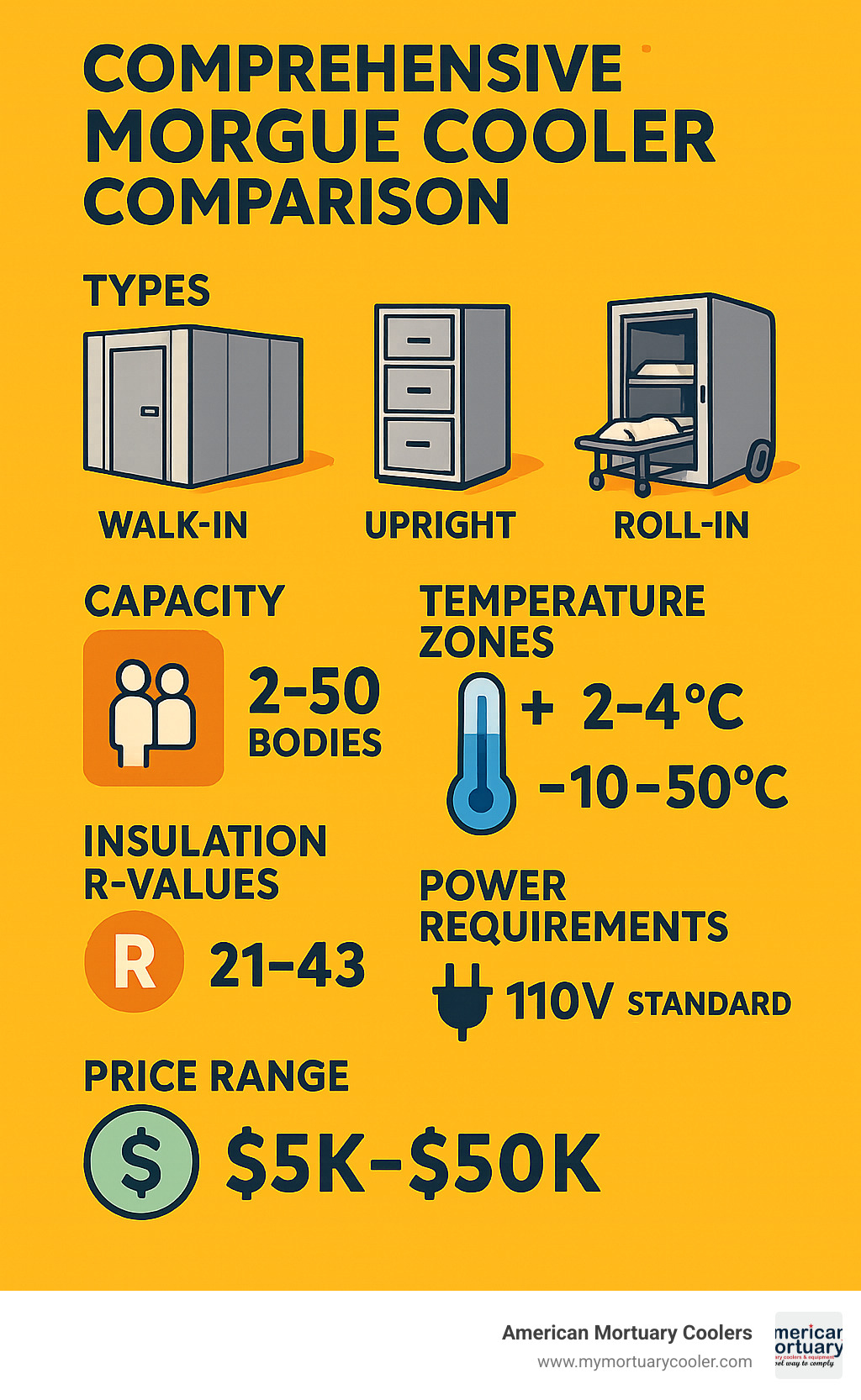
Basic morgue-cooler- glossary:
- mortuary cabinet
- embalming supplies
- funeral home supplies
Understanding morgue-cooler- Basics
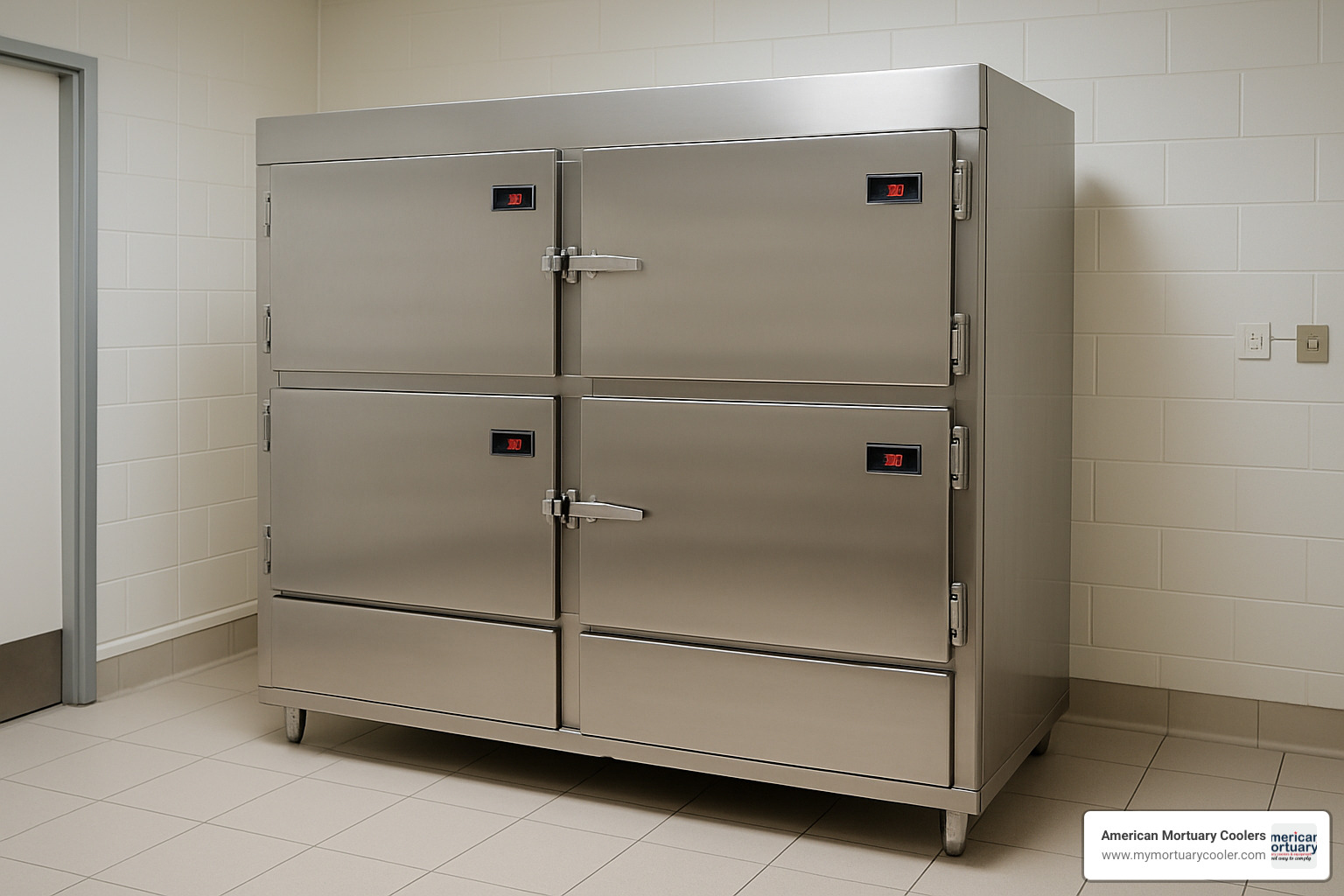
A morgue-cooler- creates the perfect environment to preserve human remains with dignity. Its primary purpose is maintaining precise temperatures and sterile conditions that slow natural decomposition, giving families time for funeral arrangements.
Every facility has different needs, which is why morgue coolers come in four main configurations. Walk-in coolers are ideal for high-volume facilities like hospitals and large funeral homes. These modular units store 9-50 bodies using precision-formed insulated panels that can be assembled, disassembled, and relocated.
Upright coolers maximize space efficiency, perfect for rural hospitals or smaller funeral homes. These compact units hold 2-15 bodies with telescoping slide rails for easy access in tight spaces.
Roll-in coolers reduce handling by accommodating full mortuary cots and stretchers, typically holding 2-3 bodies. This eliminates transfers to storage trays, preserving dignity and reducing staff strain.
Custom builds handle unique situations where standard units won't fit, ensuring maximum storage in any space.
Temperature ranges define functionality. Positive temperature units maintain 2-4°C, perfect for slowing decomposition during typical funeral timelines. Negative temperature units operate from -10°C to -50°C, serving forensic labs needing long-term preservation.
Effective cooling relies on R-value insulation. Higher R-values mean better temperature control and lower energy bills. Modern coolers use closed-cell polyurethane or polystyrene insulation with R-values ranging from 21 to 43.
Positive vs. Negative morgue-cooler- Technology
| Feature | Positive Temperature (2-4°C) | Negative Temperature (-10 to -50°C) |
|---|---|---|
| Primary Use | Standard body storage, funeral homes | Forensic labs, long-term evidence |
| Storage Duration | Days to weeks | Months to years |
| Energy Consumption | Lower operating costs | Higher power requirements |
| Pros | Cost-effective, standard operation | Extended preservation, evidence integrity |
| Cons | Limited storage time | Higher upfront and operating costs |
| Typical Facilities | Hospitals, funeral homes, morgues | Medical examiners, research facilities |
90% of facilities need positive temperature cooling for standard operations. Forensic storage demands negative temperatures for extended preservation during investigations.
How a morgue-cooler- Slows Decomposition
Decomposition occurs through bacterial action and enzymatic breakdown. A morgue-cooler- interrupts this process using a vapor-compression cycle that removes heat and controls the environment.
Refrigerant circulates through evaporator coils inside the storage chamber. Heat transfers to the refrigerant, moves to the compressor for pressurization, then gets expelled through condenser coils.
Humidity control prevents ice formation while maintaining optimal preservation. Antimicrobial interiors provide protection against bacterial growth through seamless fiberglass surfaces and specialized coatings.
Remote monitoring sensors track temperature, humidity, and system performance continuously, with alarm systems alerting staff to any issues. Gasketed doors create airtight seals maintaining internal conditions while allowing easy access.
Morgue Cooler Types, Capacities & Key Components

Choosing the right morgue-cooler- requires understanding your facility's specific needs.
Walk-in morgue coolers store 9-50 bodies, perfect for busy hospitals and large funeral homes. These modular units use prefabricated insulated panels that snap together and can be relocated without losing effectiveness.
Upright morgue coolers offer space efficiency in 2-body, 3-body, 4-body, 6-body, and 12-body configurations. A typical 4-body upright cooler costs about $9,049 and measures 94.5" deep by 44" wide by 105.5" high.
Roll-in morgue coolers eliminate transfers from stretchers to storage trays, holding 2-3 bodies with removable ramps for easy loading.
Portable and mobile units provide temporary capacity during renovations or disasters. These self-contained systems transport on trailers and can run on generators.
Custom builds address unique space requirements, maximizing storage in any facility layout.
Internal storage systems feature cantilever and telescoping rack systems that allow individual tray access without disturbing others. Bariatric storage accommodates oversized remains with reinforced construction and wider openings.
Most modern units are self-contained and plug into standard 110V outlets, eliminating special electrical work. High-R value panels come in three thicknesses: 3" panels (R-21), 4" panels (R-28 for coolers, R-32 for freezers), and premium 5-3/8" panels (R-37.6 for coolers, R-43 for freezers).
For detailed selection guidance, check out All About Morgue Coolers: Options, Features, and Buying Tips.
Critical Features of a High-Quality Unit
Insulation thickness separates excellent units from adequate ones. 3" panels with R-21 work for basic applications, but 4" panels (R-28 for coolers, R-32 for freezers) offer better efficiency. Premium 5-3/8" panels (R-37.6 for coolers, R-43 for freezers) represent the gold standard.
Sealed floors prevent contamination with NSF-approved cove base construction. LED lighting provides consistent output without flickering. Alarm systems include temperature and door alarms with remote notification capabilities.
Heated door jambs prevent frost formation, while caster mobility enables easy movement for cleaning. The choice between split and top-mount compressor systems affects performance and convenience.
Latest Innovations & Smart Add-Ons
WiFi temperature alerts enable remote monitoring through smartphone apps. CoolBot controllers pair with standard air conditioners to create affordable walk-in coolers for around $5,000.
Low-ambient kits extend operating ranges for outdoor installations. Color-matched exteriors help units blend with facility aesthetics. Modular expansion panels support future growth, while Energy Star components reduce operating costs.
For temporary capacity needs, American Mortuary Coolers can provide guidance on short-term rental solutions or modular add-ons that integrate seamlessly with your existing setup.
Selecting the Right Morgue Cooler for Your Facility
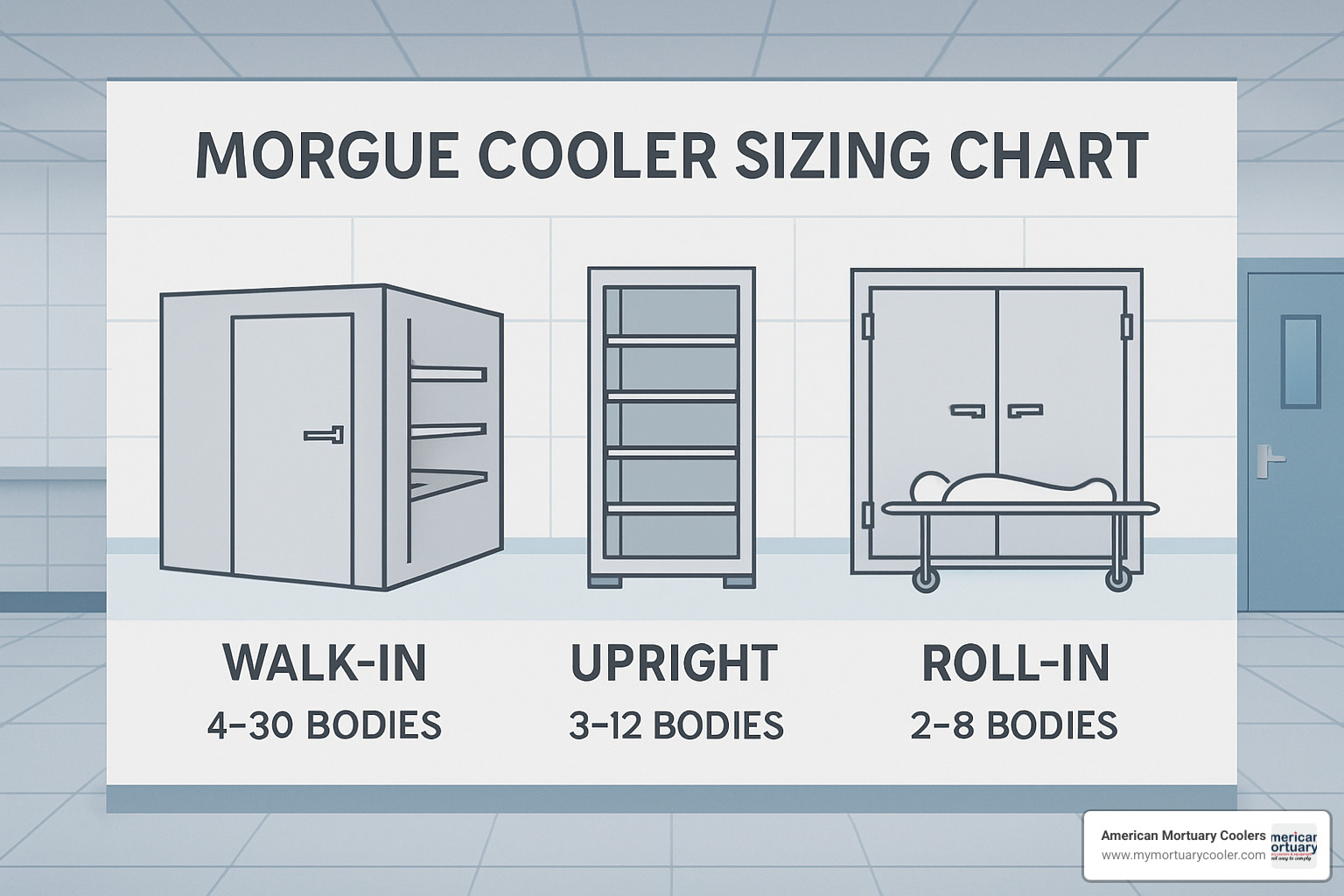
Choosing the right morgue-cooler- starts with understanding your facility's unique needs.
Hospital morgues need walk-in coolers storing 10-30 bodies with rock-solid temperature control despite frequent door openings. Funeral homes typically require 4-8 body upright or roll-in units, with choice depending on handling preferences. Coroner offices need specialized features like negative temperature capability and bariatric accommodation.
Capacity planning requires calculating average daily intake, peak demand periods, and storage duration. Add a 20-30% buffer for unexpected situations. Walk-in coolers maximize storage density, while multiple smaller units provide operational flexibility and backup.
Budget considerations include total cost of ownership over 15+ years. Basic units start around $6,095 for 2-body capacity, while premium walk-in systems reach $50,000+. Lease versus buy decisions depend on cash flow, tax situation, and facility permanence.
Warranty coverage typically includes 15-year panel and door warranties with 5-year mechanical component protection.
For comprehensive selection guidance, check out More info about morgue refrigeration options.
Key Buying Considerations & Cost Factors
Insulation quality affects both upfront costs and long-term energy bills. High R-value panels can reduce electricity costs by 30-50% compared to basic insulation.
Regulatory compliance includes NSF certification for sanitation, UL approval for electrical safety, and OSHA compliance for emergency egress handles.
Installation requires adequate electrical service, proper ventilation, structural support, and service access. Total cost of ownership over 15 years often favors higher-efficiency units despite higher initial prices.
Customization & Future-Proofing
Door configurations adapt to workflow needs, from single doors for low-traffic to double doors for busy facilities. Finish materials range from painted steel to premium stainless steel with custom color matching.
Removable ramps improve loading safety, while bariatric capabilities address growing plus-size storage needs. Shelving packages optimize internal organization, and outdoor weatherproofing protects environmental exposure.
Expansion panels offer the smartest approach to future growth, allowing modular additions as needs increase.
Installation, Maintenance & Compliance Essentials
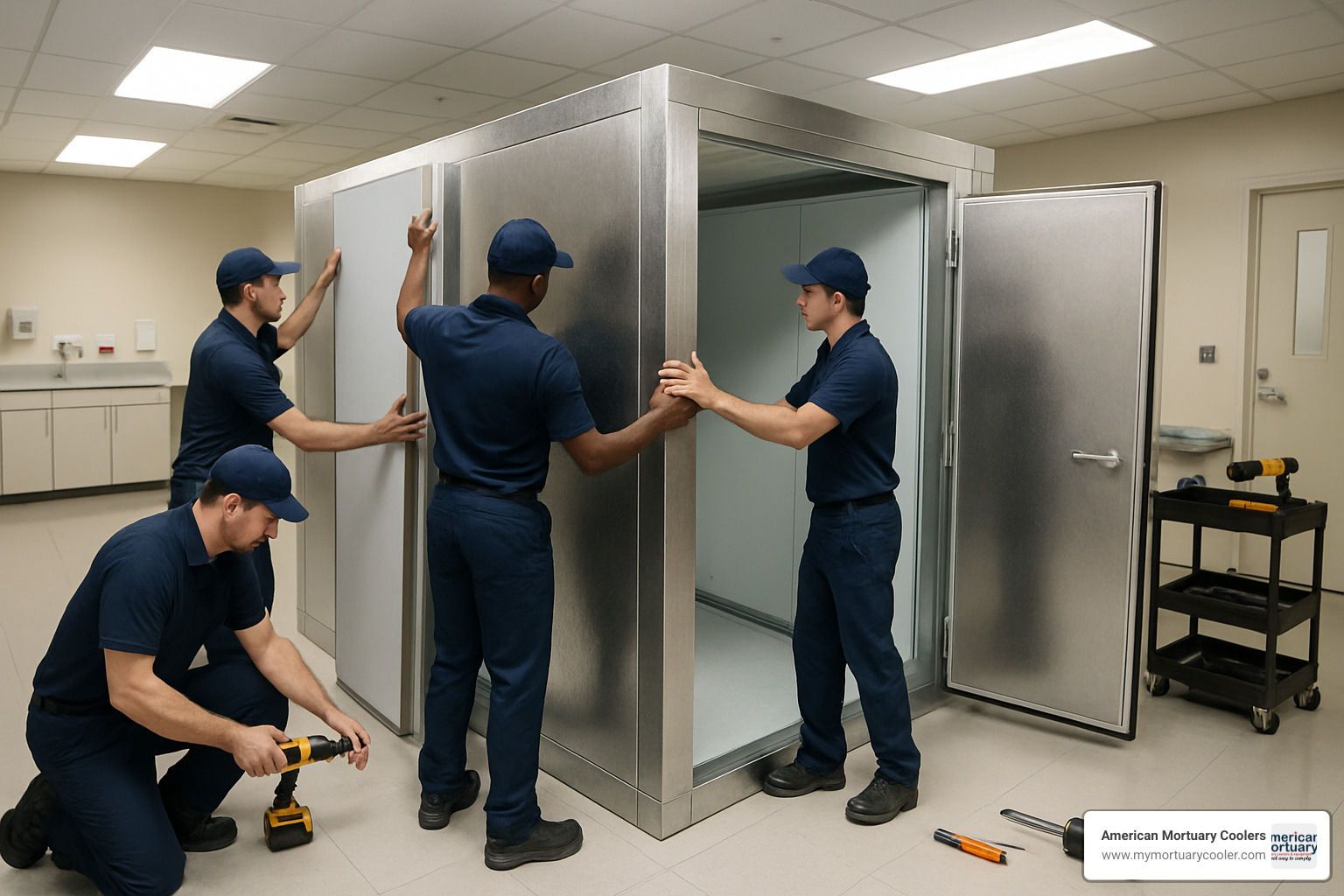
Proper installation sets the foundation for reliable morgue-cooler- service. Most modern units are designed for installation simplicity.
Floor preparation requires adequate load capacity (150-200 pounds per square foot for walk-in systems) and level surfaces to prevent door alignment issues. Electrical requirements are usually straightforward - most self-contained units plug into standard 110V outlets, while larger walk-in systems may need 220V service.
Ventilation around condensing units requires 3 feet clearance on all sides for proper airflow and heat rejection.
Cleaning protocols use approved sanitizers on seamless interior surfaces. Most facilities clean weekly or after each use. Maintenance schedules include quarterly tasks: cleaning condenser coils, checking refrigerant levels, testing alarm systems, and inspecting door seals.
Remote diagnostics transmit performance data to service technicians, enabling proactive maintenance before expensive failures occur.
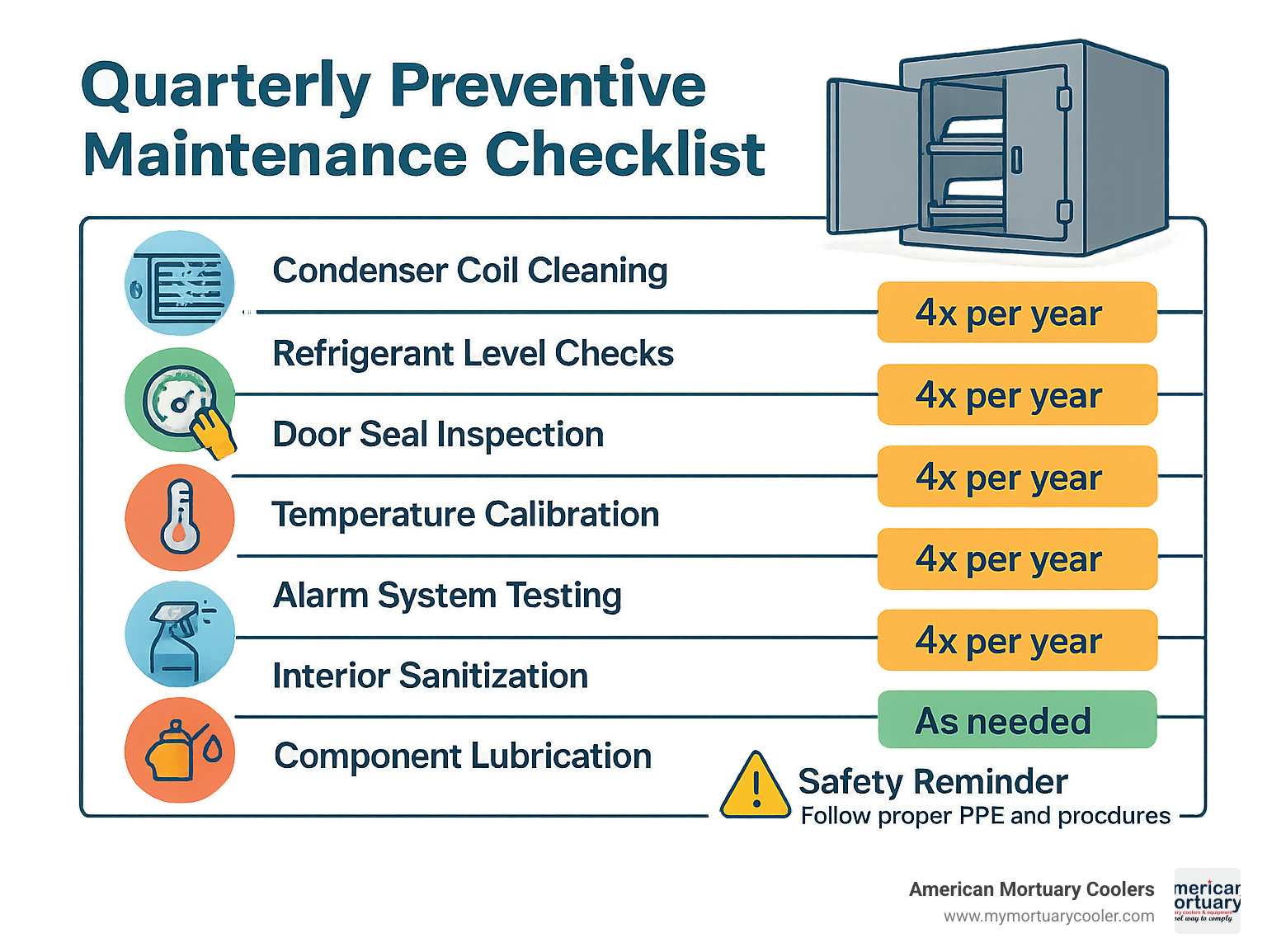
Regulatory & Certification Checklist
NSF sanitation standards ensure food-grade construction for interior surfaces and cleanability. UL safety certification addresses electrical components and operational hazards. OSHA egress handles provide emergency exit capability from walk-in units.
EISA energy rules regulate efficiency under the Federal Energy Independence & Security Act. Local health codes may add requirements beyond federal standards. Disaster preparedness standards may require redundant cooling or generator connections.
Energy Efficiency & Sustainability
High-R insulation typically recovers its premium cost within 2-3 years through reduced electricity bills. Variable-speed compressors reduce energy consumption by 20-30% while providing better temperature control.
LED lighting consumes 75% less energy than fluorescent alternatives with longer service life. Smart defrost systems minimize energy waste by defrosting only when necessary.
Modern refrigerants offer lower environmental impact while maintaining excellent performance. Quality morgue coolers operate reliably for 15-20 years with proper maintenance, making them sustainable long-term investments.
Frequently Asked Questions about Morgue Coolers
What temperature should a morgue cooler run at?
The sweet spot for most morgue-cooler- units is 36°F to 39°F (2-4°C). This temperature range works like a gentle pause button on decomposition - cold enough to slow bacterial growth and enzymatic breakdown, but not so cold that it damages tissues with ice formation.
Think of it as the perfect balance. Too warm, and you're not getting the preservation you need. Too cold, and you risk cellular damage that can complicate funeral preparations or forensic examinations.
Forensic facilities tell a different story. When medical examiners need to preserve evidence or unidentified remains for months or years, they turn to negative temperatures from -10°C to -50°C. These sub-freezing temperatures essentially hit the stop button on decomposition entirely. The trade-off? Higher energy bills and specialized equipment, but sometimes that long-term preservation is absolutely critical.
How many bodies can a standard walk-in hold?
Here's where capacity planning gets interesting. Walk-in morgue coolers start at 9 bodies minimum and can scale up to handle 50+ bodies depending on your space and rack setup. A typical 8'×12' walk-in cooler comfortably accommodates about 25 bodies using smart shelving systems.
The actual number depends on a few key factors. Unit dimensions obviously matter - bigger spaces hold more. Shelving configuration makes a huge difference too. Cantilever rack systems are like the Swiss Army knife of morgue storage - they maximize every square foot while still letting you access each position individually.
Body size accommodation is becoming increasingly important. With growing demand for bariatric storage, many facilities are planning for larger remains, which naturally affects total capacity. It's better to plan conservatively and have extra space than to find yourself short during busy periods.
Do I need special wiring to install a self-contained unit?
Good news for most facilities - self-contained morgue coolers are designed to plug into standard 110V outlets. No electrician required, no special permits, no headaches. These units accept the plug-and-play philosophy that makes installation straightforward and cost-effective.
Larger walk-in systems are a different animal. They often need 220V service to power the bigger compressors required for substantial cooling capacity. The electrical requirements scale with the cooling load, which makes perfect sense when you think about it.
Before you finalize any purchase, check the electrical specifications during your planning phase. Make sure your facility has adequate power available and proper circuit protection. Most manufacturers provide detailed electrical requirements upfront, so there shouldn't be any surprises on delivery day.
The beauty of modern morgue-cooler- design is that manufacturers understand funeral homes and hospitals need equipment that works without major facility modifications. That's why most units are engineered for simple installation that gets you up and running quickly.
Conclusion
Choosing the perfect morgue-cooler- comes down to understanding your facility's unique needs and matching them with the right equipment. It's not just about finding the biggest unit or the cheapest price - it's about finding that sweet spot where capacity, reliability, and budget all align.
Start with capacity planning. Walk-in systems shine when you're handling high volumes daily, giving you that maximum storage density hospitals and large funeral homes need. But don't overlook upright and roll-in units if you're running a smaller operation - they often provide exactly what you need without the overhead of a massive system.
Features matter, but some matter more than others. I've seen too many facilities get caught up in fancy digital displays while skimping on insulation quality. Here's the truth: high R-value insulation and rock-solid refrigeration components will serve you far better than a basic unit with premium finishes. Your electricity bill will thank you every month for choosing quality insulation.
Compliance isn't optional - it's essential. NSF sanitation standards, UL safety certification, and OSHA egress requirements aren't just bureaucratic boxes to check. These standards protect your staff and maintain the dignity of those in your care. Local health department regulations may add another layer, so always check with your local authorities before making final decisions.
When you're ready to move forward, American Mortuary Coolers delivers custom, USA-made units nationwide from our Tennessee facility. We understand that every facility has different needs, whether it's a compact 2-body unit for a rural funeral home or a comprehensive 50-body walk-in system for a major medical center. Our direct delivery service reaches all contiguous 48 states, ensuring you get equipment that's properly configured for your specific requirements.
The investment you make today protects tomorrow's operations. Quality morgue cooling equipment isn't just about preserving remains - it's about preserving your reputation and providing peace of mind to the families you serve during their most difficult moments. When that equipment runs reliably year after year, you can focus on what really matters: caring for people when they need it most.
Planning ahead pays off. Whether you're replacing aging equipment or setting up a new facility, taking time to evaluate your needs thoroughly ensures you'll get equipment that serves you well for decades to come.
For deeper insights into emerging technologies and operational strategies that can further improve your facility's capabilities, explore The Definitive Guide to Morgue Coolers: Selection, Operation, and Future Innovations.
















